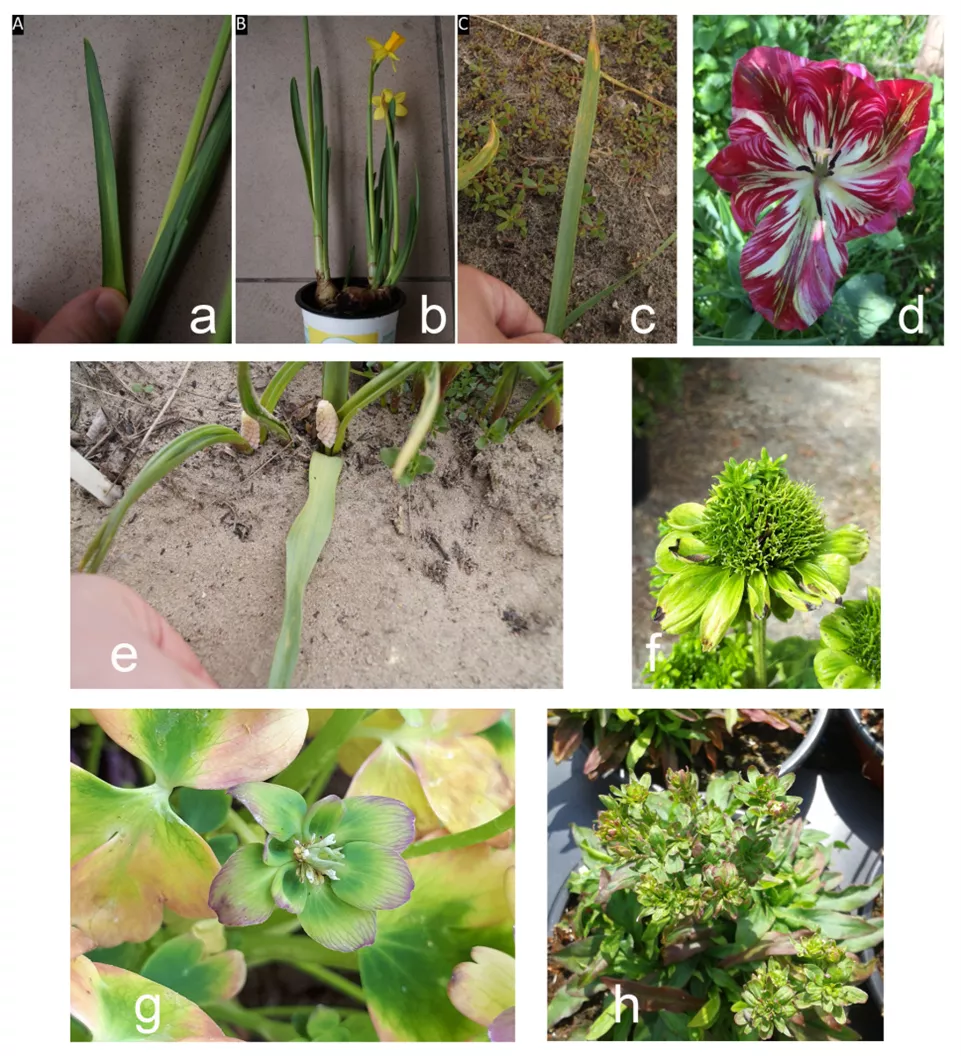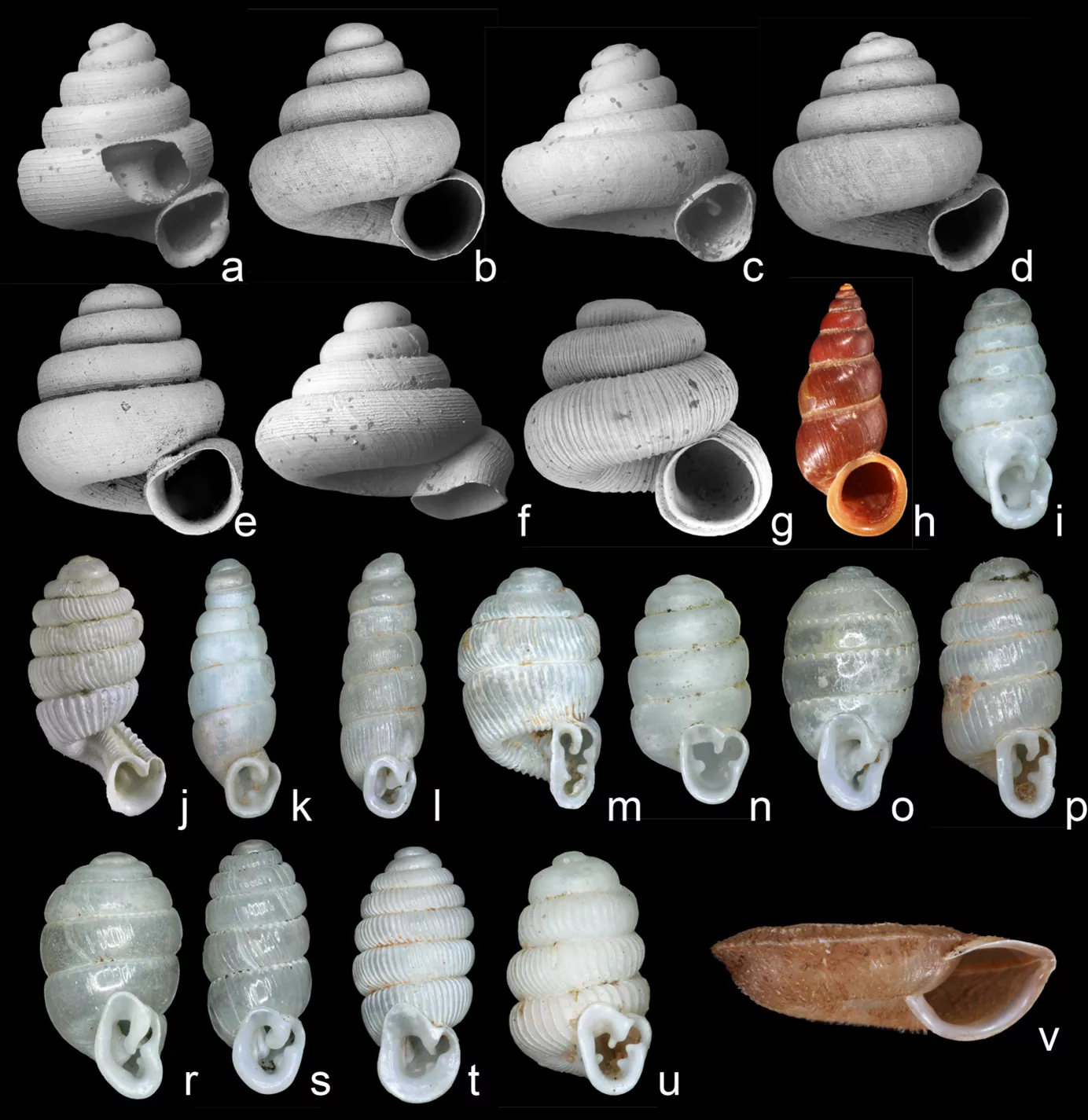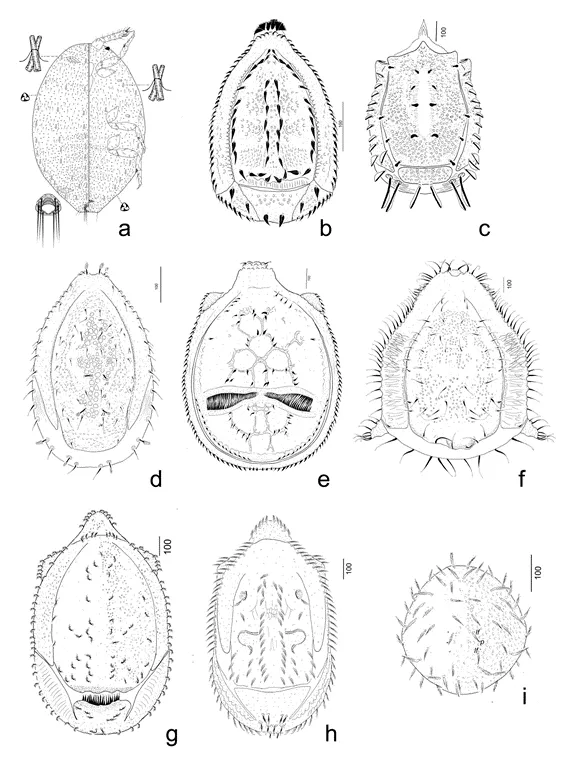The Plant Protection Institute of ELKH Centre for Agricultural Research (ATK NÖVI) has always played a significant role in the detection of emerging pathogens and pests, which can also be considered the first step in controling them. Research that requires serious classical and molecular methods and knowledge also involves getting to know close and distant relatives of pest groups, which results in the discovery of many new species for science every year. This article presents the first plant viruses and phytoplasmas, arthropod and mollusc pests detected by researchers at ATK NÖVI in Hungary in 2020, as well as the viral, snail, scale insect and mite species discovered by researchers for the first time in scientific history.
Plant pathogens detected for the first time in Hungary and described for scientific purposes
Narcissus is a popular spring plant Hungary and can be found in gardens or even planted in flower pots. Researchers of the Plant Protection Institute have detected the presence of three types of narcissus viruses for the first time in Hungary: the virus that causes late yellowing of the narcissus (Narcissus late season yellows virus), the latent narcissus virus (Narcissus latent virus) and the narcissus mosaic virus (Narcissus mosaic virus). In addition, the knight's star mosaic virus was first detected on daffodils. They also reported, for the first time, the presence of the Rembrandt tulip breaking virus (Rembrandt tulip-breaking virus) that infects the popular spring flower, the tulip, which generates the characteristic pattern of the tulip's flower. The grape hyacinth mosaic virus (Muscari mosaic virus) was first detected on our popular bulbous plant, the grape hyacinth, which also blooms in the spring. In addition, a potyvirus previously (Muscari chlorotic mottle virus) unknown to science was discovered and named grape hyacinth chlorotic spot virus.
For the first time in Hungary, the institute's researchers used molecular methods to identify the phytoplasma („Candidatus Phytoplasma asteris”) of aster yellowing on our popular horticultural ornamental plants, such as the blanket flower (Gaillardia aristata), the purple-leaved coneflower (Echinacea purpurea), the garden columbine (Aquilegia coerulea) and the campion (Lychnis flos-cuculi). The discovery and detection of new pathogens was carried out by the staff of the institute together with the researchers of Szent István University (Hungarian University of Agricultural and Life Sciences) and János Neumann University.

Figure 1: Symptoms caused by pathogens detected for the first time in Hungary. a), b) and c): combined symptom of narcissus latent virus and knight's star mosaic virus on narcissus - a) green buds, b) in flowering state, c) after flowering in the open field; d): Rembrandt tulip breaking virus symptom on tulips; e): a potyvirus now discovered for science, a symptom of the grape hyacinth chlorotic spot virus on grape hyacinth; f), g) and h): symptoms of aster-yellowing phytoplasma a) on a coneflower, b) on a columbine, c) on a campion
Pests first detected in Hungary
In 2020, over the course of research two non-native species of slugs, namely the black-headed slug snail [Krynickillus melanocephalus Kaleniczenko, 1851] and the tandonia [Tandonia kusceri (Wagner, 1931)], were detected for the first time in Hungary by the institute's researchers. Both species are already widespread throughout the country and, unfortunately, can be expected to cause harm. A species of mite introduced from East Asia [Aceria bambusae Channabasavanna, 1966] has also been found on popular and often planted bamboo plants. Two of the insects, a true bug species hitherto not known in Hungary, the common broom bug on papilionaceae [Arytaina genistae (Latreille, 1804)] and the yellow pear sucker damaging pears [Cacopsylla bidens (Šulc, 1907)], were found during exploratory work. The staff of the institute detected these pests in Hungary during their joint research with colleagues working at Szent István University (Hungarian University of Agricultural and Life Sciences), the National Food Chain Safety Office and the Hungarian Museum of Natural History.

Figure 2: Pests detected for the first time in Hungary. a) Tandonia kusceri (Wagner, 1931); b) Krynickillus melanocephalus (Kaleniczenko, 1851); c) Aceria bambusae Channabasavanna, 1966; d) Cacopsylla bidens (Šulc, 1907); e) Arytaina genistae (Latreille, 1804)
Discovering new invertebrates for science
In 2020, a large number (30) of species previously unknown to science were discovered by researchers at ELKH ATK NÖVI, primarily in the framework of international collaboration. The largest number (21) of new terrestrial snail species were found, mainly during exploration work in Southeast Asia. The Institute discovered four species for scientific purposes from Myanmar [Landouria intha Páll-Gergely, Hunyadi & Hausdorf, 2020; Diaphera polita Páll-Gergely, 2020; Diaphera turbanophora Páll-Gergely & Grego, 2020; Sinoennea montawana Páll-Gergely & Hunyadi, 2020], ten species from Laos [Sinoennea angustistoma Páll-Gergely, A. Reischütz & Maassen, 2020; Sinoennea infantilis Páll-Gergely & Grego, 2020; Sinoennea ljudmilena Páll-Gergely, 2020; Sinoennea otostoma Páll-Gergely, A. Reischütz & Maassen, 2020; Sinoennea variabilis Páll-Gergely & Grego, 2020; Laoennea carychioides Páll-Gergely, A. Reischütz & Maassen, 2020; Kontschania tetragyra Páll-Gergely & Grego, 2020; Clostophis obtusus Páll-Gergely & Grego, 2020; Clostophis infantilis Páll-Gergely, 2020; Clostophis multiformis Páll-Gergely & A. Reischütz, 2020], four species from Vietnam [Clostophis incurvus Páll-Gergely & Vermeulen, 2020; Clostophis koilobasis Páll-Gergely & Vermeulen, 2020; Clostophis platytrochus Páll-Gergely & Hunyadi, 2020; Coptocheilus maunautim Bui & Páll-Gergely, 2020], two species from Thailand [Sinoennea panhai Páll-Gergely & Hunyadi, 2020; Sinoennea sutchariti Páll-Gergely & Hunyadi, 2020] and one species from China [Diaphera lini Z.-Y. Chen & Páll-Gergely, 2020]. Insect research has also led to the discovery and description of a hitherto unknown species of scale insect from Peru. During the study of mites, eight hitherto unknown species from Africa were discovered. The Mahnertellina paradoxa, Kontschán 2020, Rotundabaloghia (Circobaloghia) olszanowskii, Kontschán 2020, and the Origmatrachys mahnerti, Kontschán, 2020, from Zimbabwe the Bloszykiella rammsteini Kontschán & Ermilov, 2020, from Ruanda the Bloszykiella lindemanni Kontschán & Ermilov, 2020 species. From South-America, Peru, the Afrotrachytes peruensis Kontschán & Fridrich, 2020 and Formosaurella tertia Kontschán & Fridrich, 2020 species, from Jemen the Discotrachytes vanharteni Kontschán, 2020 species.

Figure 3: Newly discovered snail species for science. a) Clostophis incurvus Páll-Gergely & Vermeulen, 2020; b) Clostophis infantilis Páll-Gergely, 2020; c) Clostophis koilobasis Páll-Gergely & Vermeulen, 2020; d) Clostophis multiformis Páll-Gergely & A. Reischütz, 2020; e) Clostophis obtusus Páll-Gergely & Grego, 2020; f) Clostophis platytrochus Páll-Gergely & Hunyadi, 2020; g) Kontschania tetragyra Páll-Gergely & Grego, 2020; h) Coptocheilus maunautim Bui & Páll-Gergely, 2020; i) Laoennea carychioides Páll-Gergely, A. Reischütz & Maassen, 2020; j) Diaphera lini Z.-Y. Chen & Páll-Gergely, 2020; k) Diaphera polita Páll-Gergely, 2020; l) Diaphera turbanophora Páll-Gergely & Grego, 2020; m) Sinoennea angustistoma Páll-Gergely, A. Reischütz & Maassen, 2020; n) Sinoennea infantilis Páll-Gergely & Grego, 2020; o) Sinoennea ljudmilena Páll-Gergely, 2020; p) Sinoennea montawana Páll-Gergely & Hunyadi, 2020; r) Sinoennea otostoma Páll-Gergely, A. Reischütz & Maassen, 2020; s) Sinoennea panhai Páll-Gergely & Hunyadi, 2020; t) Sinoennea sutchariti Páll-Gergely & Hunyadi, 2020; u) Sinoennea variabilis Páll-Gergely & Grego, 2020; v) Landouria intha Páll-Gergely, Hunyadi & Hausdorf, 2020

Figure 4: Newly discovered insect and mite species for science. a) Ripersiella incarum Kaydan & Szita, 2020; b) Formosaurella tertia Kontschán & Fridrich, 2020; c) Afrotrachytes peruensis Kontschán & Fridrich, 2020; d) Discotrachytes vanharteni Kontschán, 2020; e) Origmatrachys mahnerti Kontschán, 2020; f) Mahnertellina paradoxa Kontschán, 2020; g) Bloszykiella lindemanni Kontschán & Ermilov, 2020; h) Bloszykiella rammsteini Kontschán & Ermilov, 2020; i) Rotundabaloghia (Circobaloghia) olszanowskii Kontschán, 2020